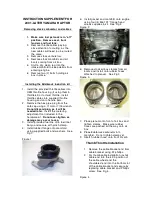
When the ignition is switched on, several warning and indicator lights come on briefly for a function
check. They go out after a few seconds.
WARNING
Incorrect tire pressures and/or underinflation can cause sudden tire failure, loss of control,
collision, serious personal injury, or even death.
x
When the warning symbol
appears in the instrument cluster, stop the vehicle as soon
as it is safe to do so and inspect all tires.
x
Incorrect tire pressure and/or underinflation can cause increased tire wear and can affect
the handling of the vehicle and its stopping ability.
x
Incorrect tire pressure and/or underinflation can also lead to sudden tire failure, including
a blowout and sudden deflation, causing loss of vehicle control.
x
The driver is responsible for the correct tire pressures for all tires on the vehicle. The
recommended tire pressure values are listed on a sticker inside the fuel filler flap inside the
driver door.
x
The TPMS can only work correctly when all tires on the vehicle are filled to the correct
cold tire inflation pressure. Always maintain the correct cold tire inflation pressure so that
TPMS can do its job.
x
Using incorrect tire pressure values can cause accidents or other damage. Check the
pressure in all 4 tires when the tires are still cold. Never reduce air pressure in warm tires to
match cold tire inflation pressure.
x
Always inflate the tires to the correct specified cold tire pressure values for the tires
installed on the vehicle; see the tire inflation pressure label on the driver door jamb.
x
Always inflate tires to the recommended and correct tire pressure before driving off.
x
Driving with underinflated tires causes them to flex (bend) more, letting them get too hot,
which can result in tread separation, sudden tire failure, and loss of control.
x
Excessive speed and/or overloading can cause heat build-up, sudden tire failure, and loss
of control.
x
If the tire pressure is too low or too high, the tires will wear prematurely and the vehicle
will not handle well.
x
If the tire is not “flat” and you do not have to change the tire or wheel immediately, drive at
reduced speed to the nearest service station to check the tire pressure and add air as
required.
x
When replacing tires or wheel rims on vehicles equipped with TPMS, always read and
heed the information and all WARNINGS in the section.
x
The Tire Pressure Monitoring System must be recalibrated using the SET button whenever
you remove and remount or change any wheel or tire on the vehicle, even if the reinstalled or
replacement wheels and tires are identical to those that were removed and even if the tire
pressure does not change.
WARNING
Improper use of the SET button can cause the TPMS to give false warnings or to give no
warning despite dangerously low tire.
















































